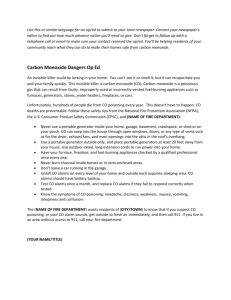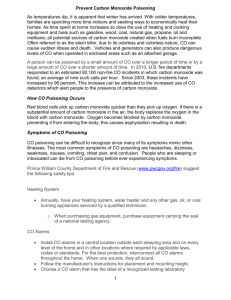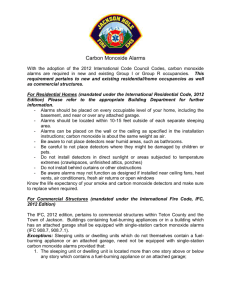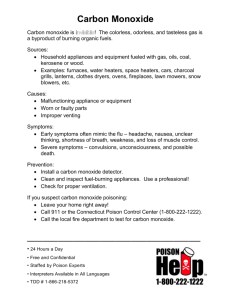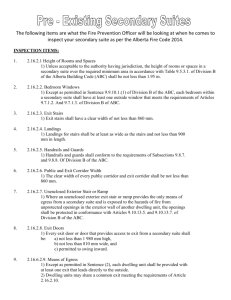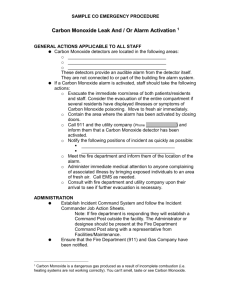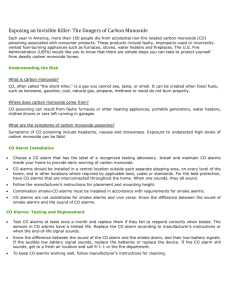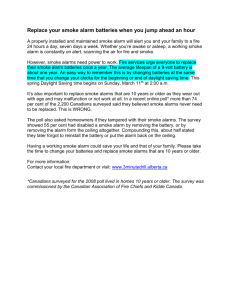FIRE PROTECTION AND PREVENTION ACT, 1997
advertisement
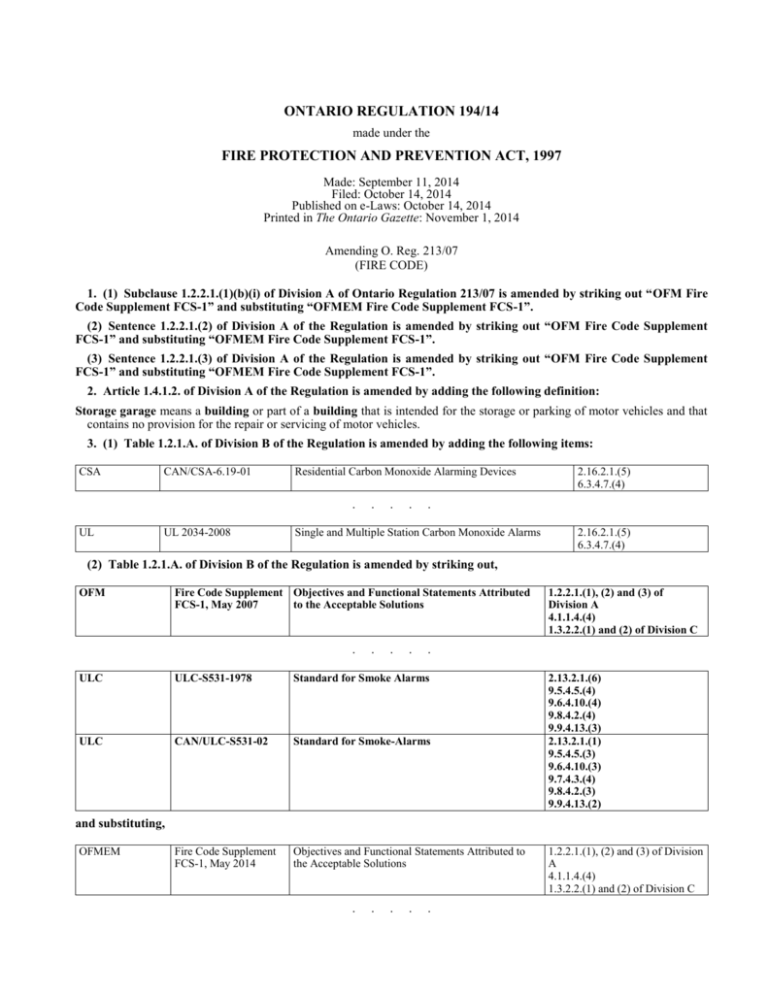
ONTARIO REGULATION 194/14 made under the FIRE PROTECTION AND PREVENTION ACT, 1997 Made: September 11, 2014 Filed: October 14, 2014 Published on e-Laws: October 14, 2014 Printed in The Ontario Gazette: November 1, 2014 Amending O. Reg. 213/07 (FIRE CODE) 1. (1) Subclause 1.2.2.1.(1)(b)(i) of Division A of Ontario Regulation 213/07 is amended by striking out “OFM Fire Code Supplement FCS-1” and substituting “OFMEM Fire Code Supplement FCS-1”. (2) Sentence 1.2.2.1.(2) of Division A of the Regulation is amended by striking out “OFM Fire Code Supplement FCS-1” and substituting “OFMEM Fire Code Supplement FCS-1”. (3) Sentence 1.2.2.1.(3) of Division A of the Regulation is amended by striking out “OFM Fire Code Supplement FCS-1” and substituting “OFMEM Fire Code Supplement FCS-1”. 2. Article 1.4.1.2. of Division A of the Regulation is amended by adding the following definition: Storage garage means a building or part of a building that is intended for the storage or parking of motor vehicles and that contains no provision for the repair or servicing of motor vehicles. 3. (1) Table 1.2.1.A. of Division B of the Regulation is amended by adding the following items: CSA CAN/CSA-6.19-01 Residential Carbon Monoxide Alarming Devices . UL UL 2034-2008 . . . 2.16.2.1.(5) 6.3.4.7.(4) . Single and Multiple Station Carbon Monoxide Alarms 2.16.2.1.(5) 6.3.4.7.(4) (2) Table 1.2.1.A. of Division B of the Regulation is amended by striking out, OFM Fire Code Supplement Objectives and Functional Statements Attributed FCS-1, May 2007 to the Acceptable Solutions . . . . 1.2.2.1.(1), (2) and (3) of Division A 4.1.1.4.(4) 1.3.2.2.(1) and (2) of Division C . ULC ULC-S531-1978 Standard for Smoke Alarms ULC CAN/ULC-S531-02 Standard for Smoke-Alarms Fire Code Supplement FCS-1, May 2014 Objectives and Functional Statements Attributed to the Acceptable Solutions 2.13.2.1.(6) 9.5.4.5.(4) 9.6.4.10.(4) 9.8.4.2.(4) 9.9.4.13.(3) 2.13.2.1.(1) 9.5.4.5.(3) 9.6.4.10.(3) 9.7.4.3.(4) 9.8.4.2.(3) 9.9.4.13.(2) and substituting, OFMEM . . . . . 1.2.2.1.(1), (2) and (3) of Division A 4.1.1.4.(4) 1.3.2.2.(1) and (2) of Division C 2 ULC ULC-S531-1978 Standard for Smoke Alarms ULC CAN/ULC-S531-02 Standard for Smoke-Alarms 9.5.4.5.(4) 9.6.4.10.(4) 9.8.4.2.(4) 9.9.4.13.(3) 2.13.2.1.(3) 9.5.4.5.(3) 9.6.4.10.(3) 9.7.4.3.(4) 9.8.4.2.(3) 9.9.4.13.(2) 4. Article 1.2.2.1. of Division B of the Regulation is amended by adding the following item: OFMEM Ontario Office of the Fire Marshal and Emergency Management 5. Section 2.13 of Division B of the Regulation is revoked and the following substituted: SECTION 2.13 INSTALLATION OF SMOKE ALARMS Subsection 2.13.1. Application and Responsibility Application 2.13.1.1. (1) Subject to Sentences (2) and (3), this Section applies to dwelling units and sleeping rooms not within a dwelling unit. (2) This Section does not apply to buildings that are subject to Part 9. (3) This Section does not apply if smoke alarms have been installed in the dwelling unit or sleeping room not within a dwelling unit in accordance with the Building Code as it read on or after April 6, 1998. Landlord is responsible 2.13.1.2. Despite the definition of owner in Article 1.4.1.2. of Division A, in the case of a rental dwelling unit, only the landlord shall be considered to be the owner for the purpose of applying Article 1.2.1.1. of Division A to this Section. Subsection 2.13.2. Installation Requirements Installation requirements 2.13.2.1. (1) A smoke alarm shall be installed (a) if a sleeping area in a dwelling unit is served by a hallway, in the hallway, (b) if a sleeping area in a dwelling unit is not served by a hallway, between the sleeping area and the remainder of the dwelling unit, (c) if a sleeping room is not within a dwelling unit, in the sleeping room, and (d) on each storey without a sleeping area in a dwelling unit. (2) A smoke alarm shall (a) be permanently connected to an electrical circuit with no disconnect switch between the overcurrent device and the smoke alarm, or (b) be battery-operated. (3) A smoke alarm shall meet the requirements of CAN/ULC-S531, “Standard for Smoke Alarms”. 6. Part 2 of Division B of the Regulation is amended by adding the following Section: SECTION 2.16 INSTALLATION OF CARBON MONOXIDE ALARMS Subsection 2.16.1. Application and Responsibility Application 2.16.1.1. (1) Subject to Sentence (2), this Section applies to every building that contains a residential occupancy and (a) a fuel-burning appliance, (b) a fireplace, or (c) a storage garage. 3 (2) This Section applies (a) as of April 15, 2015, in the case of buildings that contain no more than six suites of residential occupancy, and (b) as of October 15, 2015, in the case of buildings that contain more than six suites of residential occupancy. Landlord is responsible 2.16.1.2. Despite the definition of owner in Article 1.4.1.2. of Division A, in the case of a rental dwelling unit, including a rental dwelling unit subject to Section 9.8, only the landlord shall be considered to be the owner for the purpose of applying Article 1.2.1.1. of Division A to this Section. Subsection 2.16.2. Installation Requirements Installation requirements 2.16.2.1. (1) If a fuel-burning appliance or a fireplace is installed in a suite of residential occupancy, a carbon monoxide alarm shall be installed adjacent to each sleeping area in the suite. (2) If a fuel-burning appliance is installed in a service room that is not in a suite of residential occupancy, a carbon monoxide alarm shall be installed (a) in the service room, and (b) adjacent to each sleeping area in each suite of residential occupancy that has a common wall or common floor/ceiling assembly with the service room. (3) If a building contains a storage garage, a carbon monoxide alarm shall be installed adjacent to each sleeping area in each suite of residential occupancy that has a common wall or common floor/ceiling assembly with the storage garage. (4) A carbon monoxide alarm shall (a) be permanently connected to an electrical circuit with no disconnect switch between the overcurrent device and the carbon monoxide alarm, (b) be battery-operated, or (c) be plugged into an electrical receptacle. (5) A carbon monoxide alarm shall meet the requirements of CAN/CSA-6.19, “Residential Carbon Monoxide Alarming Devices” or UL 2034, “Single and Multiple Station Carbon Monoxide Alarms”. (6) A carbon monoxide alarm shall be mechanically fixed, attached, plugged in or placed at the manufacturer’s recommended height or, if the manufacturer has not recommended a height, on or near the ceiling. (7) A carbon monoxide alarm that is installed adjacent to a sleeping area shall be equipped with an alarm that is audible throughout the sleeping area, even if any doors between the carbon monoxide alarm and any parts of the sleeping area are closed. 7. Sentence 4.1.1.4.(4) of Division B of the Regulation is amended by striking out “OFM Fire Code Supplement FCS-1” and substituting “OFMEM Fire Code Supplement FCS-1”. 8. The heading to Section 6.3 of Division B of the Regulation is amended by striking out “Fire”. 9. Subsection 6.3.3. of Division B of the Regulation is revoked and the following substituted: Subsection 6.3.3. Smoke Alarms — Maintenance and Testing Application 6.3.3.1. (1) This Subsection applies to smoke alarms in (a) dwelling units, including dwelling units subject to Section 9.8, (b) guest suites, (c) sleeping rooms not within a dwelling unit, and (d) other occupancies in which smoke alarms are required by the Building Code. Landlord is responsible 6.3.3.2. Despite the definition of owner in Article 1.4.1.2. of Division A, in the case of a rental dwelling unit, including a rental dwelling unit subject to Section 9.8, only the landlord shall be considered to be the owner for the purpose of applying Article 1.2.1.1. of Division A to this Subsection. Duty to maintain in operating condition 6.3.3.3. (1) Smoke alarms shall be maintained in operating condition. 4 (2) Primary and secondary power supplies that serve smoke alarms shall be maintained in operating condition. Maintenance instructions to be given to tenant 6.3.3.4. The landlord of each rental dwelling unit, including a rental dwelling unit subject to Section 9.8, shall give the tenant a copy of the smoke alarm manufacturer’s maintenance instructions or approved alternative maintenance instructions. Tenant to notify landlord 6.3.3.5. (1) A tenant of a rental dwelling unit, including a rental dwelling unit subject to Section 9.8, shall notify the landlord as soon as the tenant becomes aware that (a) a smoke alarm in the unit is disconnected, (b) a smoke alarm in the unit is not operating, or (c) the operation of a smoke alarm in the unit is impaired. Disabling prohibited 6.3.3.6. No person shall disable a smoke alarm. Replacement 6.3.3.7. (1) A smoke alarm shall be replaced within the time frame indicated in the manufacturer’s instructions. (2) When a smoke alarm is replaced (a) in the case of a dwelling unit subject to Part 9, including a dwelling unit subject to Section 9.8, the replacement shall not provide a lower level or type of protection than that required by Part 9, (b) in the case of a dwelling unit not subject to Part 9 and constructed on or after April 6, 1998, the replacement shall not provide a lower level or type of protection than that required by the Building Code in effect at the time of construction of the dwelling unit, and (c) in the case of a dwelling unit not subject to Part 9 and constructed before April 6, 1998, the replacement shall not provide a lower level or type of protection than that required by Article 2.13.2.1. (3) The Chief Fire Official may approve an alternative to a requirement of Sentence (2) if, in the opinion of the Chief Fire Official, the alternative provides fire safety protection equivalent to or greater than the fire safety protection that would be provided by the requirement. Testing 6.3.3.8. (1) This Article applies to rental dwelling units, including rental dwelling units subject to Section 9.8. (2) The landlord shall test smoke alarms annually and after every change in tenancy. (3) The landlord shall test battery-operated smoke alarms after the battery is replaced. (4) The landlord shall test smoke alarms that are connected to an electrical circuit after any change is made to the electrical circuit. (5) For the purposes of Sentences (2), (3) and (4), smoke alarms shall be tested by activating the smoke alarm test feature. 10. Section 6.3 of Division B of the Regulation is amended by adding the following Subsection: Subsection 6.3.4. Carbon Monoxide Alarms — Maintenance and Testing Application 6.3.4.1. This Subsection applies to carbon monoxide alarms in buildings containing a residential occupancy. Landlord is responsible 6.3.4.2. Despite the definition of owner in Article 1.4.1.2. of Division A, in the case of a rental dwelling unit, including a rental dwelling unit subject to Section 9.8, only the landlord shall be considered to be the owner for the purpose of applying Article 1.2.1.1. of Division A to this Subsection. Duty to maintain in operating condition 6.3.4.3. (1) Carbon monoxide alarms shall be maintained in operating condition. (2) Primary and secondary power supplies that serve carbon monoxide alarms shall be maintained in operating condition. Maintenance instructions to be given to tenant 5 6.3.4.4. The landlord of each rental dwelling unit, including a rental dwelling unit subject to Section 9.8, shall give the tenant a copy of the carbon monoxide alarm manufacturer’s maintenance instructions or approved alternative maintenance instructions. Tenant to notify landlord 6.3.4.5. (1) A tenant of a rental dwelling unit, including a rental dwelling unit subject to Section 9.8, shall notify the landlord as soon as the tenant becomes aware that (a) a carbon monoxide alarm in the unit is disconnected, (b) a carbon monoxide alarm in the unit is not operating, or (c) the operation of a carbon monoxide alarm in the unit is impaired. Disabling prohibited 6.3.4.6. No person shall disable a carbon monoxide alarm. Replacement in certain buildings 6.3.4.7. (1) Subject to Sentence (2), this Article applies to every building that contains a residential occupancy and (a) a fuel-burning appliance, (b) a fireplace, or (c) a storage garage. (2) This Article applies (a) as of April 15, 2015, in the case of buildings that contain no more than six suites of residential occupancy, and (b) as of October 15, 2015, in the case of buildings that contain more than six suites of residential occupancy. (3) A carbon monoxide alarm shall be replaced within the time frame indicated in the manufacturer’s instructions. (4) Despite Section 2.16, when a carbon monoxide alarm is replaced in a suite of residential occupancy constructed on or after August 6, 2001, the replacement (a) shall not provide a lower level or type of carbon monoxide protection than that required by the Building Code as it read on the day the suite was constructed, and (b) shall comply with CAN/CSA-6.19, “Residential Carbon Monoxide Alarming Devices” or UL 2034, “Single and Multiple Station Carbon Monoxide Alarms”. (5) When a carbon monoxide alarm is replaced in a suite of residential occupancy constructed before August 6, 2001, the replacement carbon monoxide alarm shall meet the requirements of Article 2.16.2.1. (6) The Chief Fire Official may approve an alternative to a requirement of Sentence (4) or (5) if, in the opinion of the Chief Fire Official, the alternative provides life safety protection equivalent to or greater than the life safety protection that would be provided by the requirement. Testing 6.3.4.8. (1) This Article applies to rental dwelling units, including rental dwelling units subject to Section 9.8. (2) The landlord shall test carbon monoxide alarms annually and after every change in tenancy. (3) The landlord shall test battery-operated carbon monoxide alarms after the battery is replaced. (4) The landlord shall test carbon monoxide alarms that are connected to an electrical circuit after any change is made to the electrical circuit. (5) For the purposes of Sentences (2), (3) and (4), carbon monoxide alarms shall be tested by activating the carbon monoxide alarm test feature. 11. (1) Sentence 1.3.2.2.(1) of Division C of the Regulation is amended by striking out “OFM Fire Code Supplement FCS-1” and substituting “OFMEM Fire Code Supplement FCS-1”. (2) Clause 1.3.2.2.(2)(a) of Division C of the Regulation is amended by striking out “OFM Fire Code Supplement FCS-1” and substituting “OFMEM Fire Code Supplement FCS-1”. Commencement 12. This Regulation comes into force on the later of October 15, 2014 and the day it is filed. 6 Made by: YASIR NAQVI Minister of Community Safety and Correctional Services Date made: September 11, 2014. Back to top
